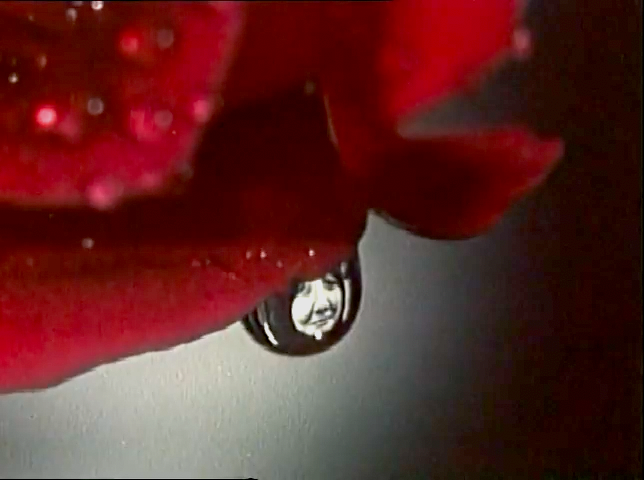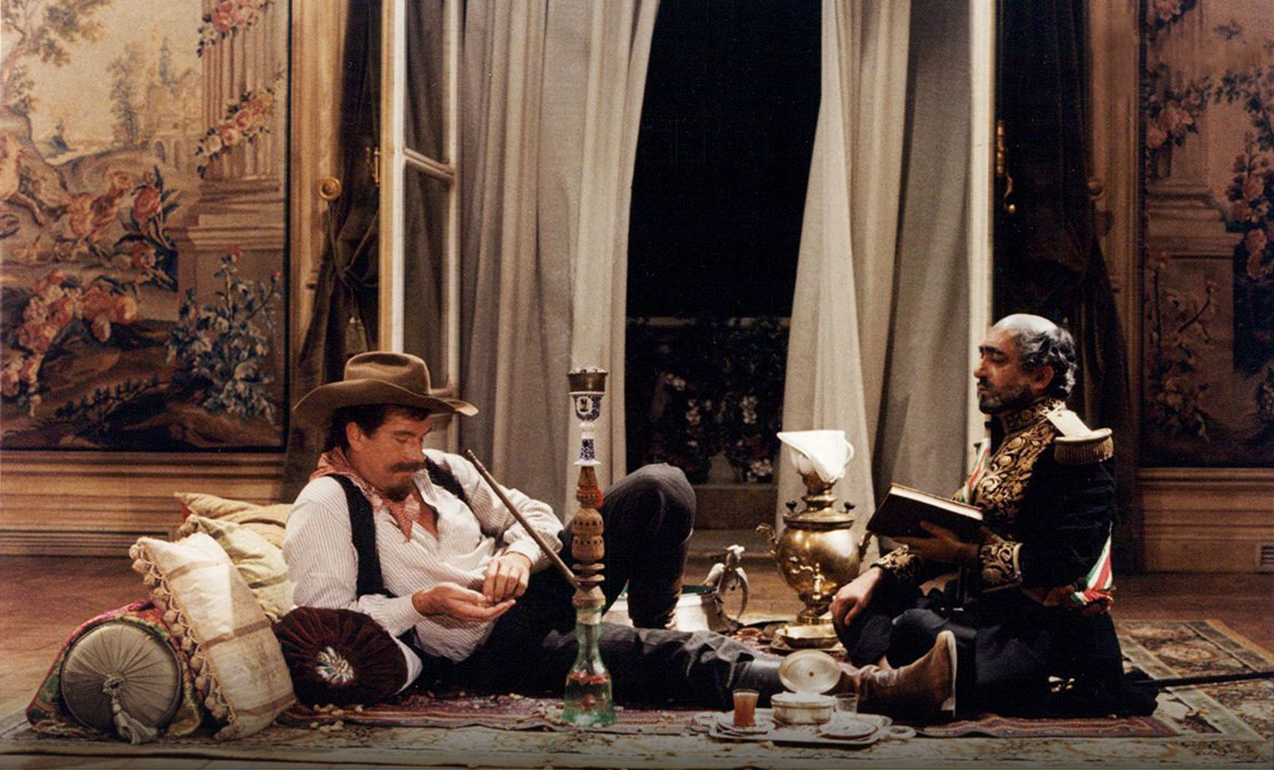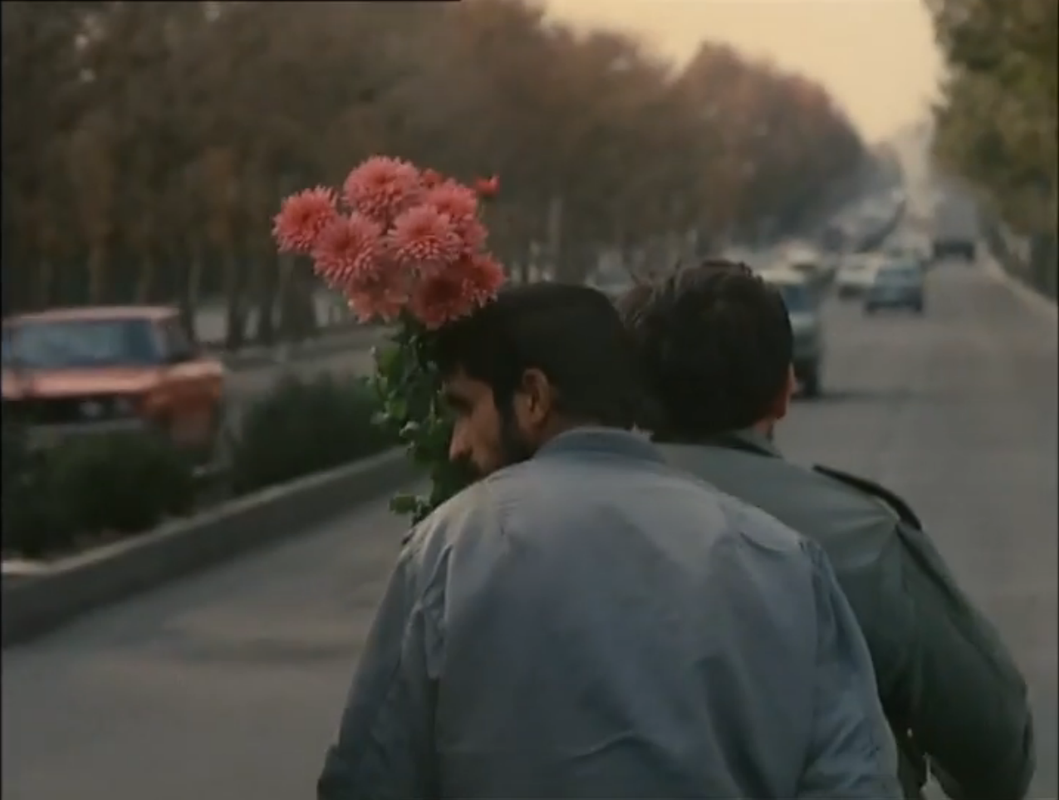آداب بهاری [Adab-e Bahari / Rites of Spring] (Ali Asghar Agahbanaei, 1982)
Aug
11
spring

In a dewdrop hanging from a rose, the face of a smiling woman appears.
Dita e Verës, a pagan spring celebration from Albania, celebrated in March: a spring scene*
The restless anticipation of spring. Iran as it was before and after the 1979 toppling of the Shah. While the snow melts away, the Revolution takes place, and fresh buds appear on the rose bushes. A poem.
* the Bales 2025 Film Challenge for August is not date-related.
Iran
غزل [Ghazal] (Masud Kimiai, 1975)
May
2
Brothers and Sisters Day

The two brothers in their forest. DP: Nemat Haghighi.
Sibling love or strife on Brothers and Sisters Day (USA)
Brothers Hojjat and Zeini live in peace in the forest. When strangers cut down the trees, a city woman joins the couple. Despite the comfort she brings with structure, food, and a warm body, the men come to realise that she's a disturbance of their peace.
حاجی واشنگتن [Hajji Washington / Haji Washington] (Ali Hatami, 1983)
Apr
30
George Washington – 1789

The ambassador and guest in the embassy. The guest, a white cowboy peeling peanuts, leisurely rests on a Persian rug with a hookah by his side. The ambassador recites from a book, with his chaii within reach (via). DP: Mehrdad Fakhimi.
The White House, or set in Washington, DC, in commemoration of the first inauguration of George Washington in 1789.
Hajji Hossein-Gholi Noori was Iran's first ambassador to the United States in 1889. Stuck in DC, homesick, and without any US-based Iranians to serve, he slowly unravels
دایره مینا [Dayereh mina / The Cycle] (Dariush Mehrjui, 1977)
Jan
23
National Blood Donor Month

Poor looking men seen squatting on the floor, one arm attached to a blood bottle. In the middle of the floor a man in a lab coat with numerous empty bottles on a pristine white table. DP: Houshang Baharlou.
Someone gives blood for National Blood Donor Month (USA). A young man who accompanies his sick father to a hospital decides to donate blood for much needed money.
– Is there anything I can do for you? – You could make a film about my suffering.کلوزآپ ، نمای نزدیک [Klūzāp, nemā-ye nazdīk / Close-Up] (Abbas Kiarostami, 1990)
Jan
19

Hossain Sabzian on the back of a motorcycle on a busy tree-lined, four lane street. He's holding a large potted rose-red dahlia. DP: Ali Reza Zarrindast.
کلوزآپ ، نمای نزدیک [Klūzāp, nemā-ye nazdīk / Close-Up] (Abbas Kiarostami, 1990)
Nov
8

Hossain Sabzian as himself. He sits behind a low table holding various refreshments, presented by his host. DP: Ali Reza Zarrindast.
“Prison is good for the good and bad for the wicked. It teaches the good a lesson but only makes the wicked worse.”کلوزآپ ، نمای نزدیک [Klūzāp, nemā-ye nazdīk / Close-Up] (Abbas Kiarostami, 1990)
Sep
8
Pardon Day

Hossain Sabzian riding passenger on a motorcycle holding a large potted rose-red dahlia. DP: Ali Reza Zarrindast.
کلوزآپ ، نمای نزدیک is visual narrative illustrating a crime. A cinephile, Hossain Sabzian, pretends to be filmmaker Mohsen Makhmalbaf and slowly extorts a family into believing to star in the director's next film.
– Hossain Sabzian
An article about the case intrigued director #Kiarostami so much that he decided to film the court case against Sabzian, and ask the accused, Makhmalbaf, and the Ahankhah family to reenact some of the events.
“Back to the old tricks.”Vérités et Mensonges [F for Fake] (Orson Welles, Gary Graver, Oja Kodar + François Reichenbach, 1973)
March
29
Smoke And Mirrors Day

A wide shot of Orson Welles in his black cape and wide rimmed hat. His corpulence and black outfit sharply contrast with the bright, white background. The background is a white plane, held up by two assistants. The wide shot reveals that Welles, the white plane, and the assistants are on the platform of a train station, obscuring a passenger train if in close-up. DP: François Reichenbach.
Vérités et Mensonges is what it's actually called, but you may know it as F for Fake. Orson Welles and three uncredited fellow conspirators – Gary Graver, Oja Kodar, and François Reichenbach – delve into the world of #art forger Elmyr de Hory by way of his biographer Clifford Irving.
– Orson Welles
Welles et al free-associate with concepts of art, lies, #deception, and #authenticity. #Houdin, Welles, #Picasso and Hughes, hoaxers, hucksters and artists in their own right. And then it's over: this work of art, this sleight of hand, this demonstration of factuality, an exposé.
